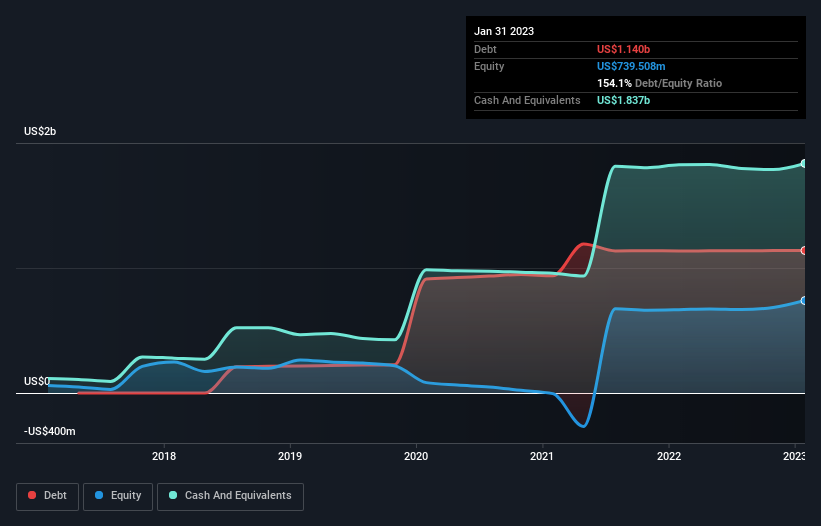
David Iben put it well when he said, 'Volatility is not a risk we care about. What we care about is avoiding the permanent loss of capital.' It's only natural to consider a company's balance sheet when you examine how risky it is, since debt is often involved when a business collapses. We can see that MongoDB, Inc. (NASDAQ:MDB) does use debt in its business. But is this debt a concern to shareholders?
When Is Debt A Problem?
Generally speaking, debt only becomes a real problem when a company can't easily pay it off, either by raising capital or with its own cash flow. In the worst case scenario, a company can go bankrupt if it cannot pay its creditors. However, a more usual (but still expensive) situation is where a company must dilute shareholders at a cheap share price simply to get debt under control. Of course, the upside of debt is that it often represents cheap capital, especially when it replaces dilution in a company with the ability to reinvest at high rates of return. When we examine debt levels, we first consider both cash and debt levels, together.
Check out our latest analysis for MongoDB
How Much Debt Does MongoDB Carry?
The chart below, which you can click on for greater detail, shows that MongoDB had US$1.14b in debt in January 2023; about the same as the year before. However, it does have US$1.84b in cash offsetting this, leading to net cash of US$696.8m.

A Look At MongoDB's Liabilities
According to the last reported balance sheet, MongoDB had liabilities of US$588.5m due within 12 months, and liabilities of US$1.26b due beyond 12 months. Offsetting these obligations, it had cash of US$1.84b as well as receivables valued at US$285.2m due within 12 months. So it actually has US$272.4m more liquid assets than total liabilities.
Having regard to MongoDB's size, it seems that its liquid assets are well balanced with its total liabilities. So while it's hard to imagine that the US$16.3b company is struggling for cash, we still think it's worth monitoring its balance sheet. Simply put, the fact that MongoDB has more cash than debt is arguably a good indication that it can manage its debt safely. There's no doubt that we learn most about debt from the balance sheet. But ultimately the future profitability of the business will decide if MongoDB can strengthen its balance sheet over time. So if you want to see what the professionals think, you might find this free report on analyst profit forecasts to be interesting.
In the last year MongoDB wasn't profitable at an EBIT level, but managed to grow its revenue by 47%, to US$1.3b. Shareholders probably have their fingers crossed that it can grow its way to profits.
So How Risky Is MongoDB?
By their very nature companies that are losing money are more risky than those with a long history of profitability. And in the last year MongoDB had an earnings before interest and tax (EBIT) loss, truth be told. And over the same period it saw negative free cash outflow of US$20m and booked a US$345m accounting loss. While this does make the company a bit risky, it's important to remember it has net cash of US$696.8m. That means it could keep spending at its current rate for more than two years. With very solid revenue growth in the last year, MongoDB may be on a path to profitability. Pre-profit companies are often risky, but they can also offer great rewards. The balance sheet is clearly the area to focus on when you are analysing debt. However, not all investment risk resides within the balance sheet - far from it. To that end, you should be aware of the 2 warning signs we've spotted with MongoDB .
When all is said and done, sometimes its easier to focus on companies that don't even need debt. Readers can access a list of growth stocks with zero net debt 100% free, right now.
New: Manage All Your Stock Portfolios in One Place
We've created the ultimate portfolio companion for stock investors, and it's free.
• Connect an unlimited number of Portfolios and see your total in one currency
• Be alerted to new Warning Signs or Risks via email or mobile
• Track the Fair Value of your stocks
Have feedback on this article? Concerned about the content? Get in touch with us directly. Alternatively, email editorial-team (at) simplywallst.com.
This article by Simply Wall St is general in nature. We provide commentary based on historical data and analyst forecasts only using an unbiased methodology and our articles are not intended to be financial advice. It does not constitute a recommendation to buy or sell any stock, and does not take account of your objectives, or your financial situation. We aim to bring you long-term focused analysis driven by fundamental data. Note that our analysis may not factor in the latest price-sensitive company announcements or qualitative material. Simply Wall St has no position in any stocks mentioned.
About NasdaqGM:MDB
Flawless balance sheet and fair value.
Similar Companies
Market Insights
Community Narratives




